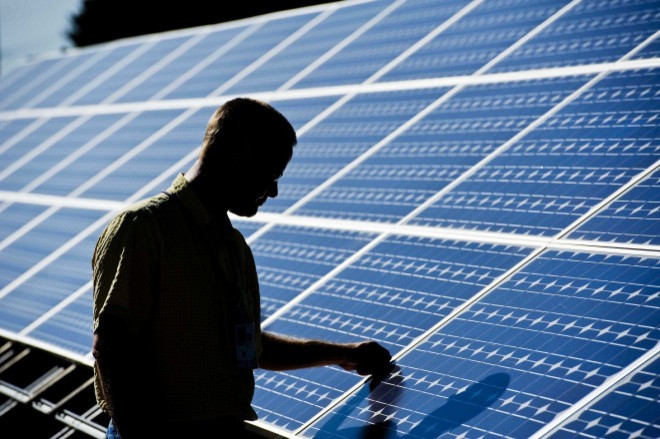Supply-demand picture darkens outlook for solar energy

Solar energy stocks received a load of bad news last week when an analyst at Credit Suisse downgraded the entire sector and lowered price targets, raising concerns about the industry's near-term prospects
Analyst Satya Kumar wrote “we have grown more concerned that subsidy-driven solar market demand cannot keep up with incremental solar supply coming online from mid-2011.”
Essentially, capacity (supply) is steadily increasing, while demand is expected to flatten or even decrease next year -- primarily because cash-strapped governments in Europe, notably Germany and France, are certain to cut subsidies for alternative energy as they confront huge spending cuts.
In fact, Kumar of Credit Suisse cited that new cell capacity is being added at a rate of 2 gigawatts per month in the fourth quarter of 2010, while the top 20 solar producer are seeking to raise production by 50 percent year-over-year in 2011.
“In addition to the top-20, there are new entrants also planning to add production in 2011,” he wrote. “As a result, factory utilizations should start falling from the first quarter of 2011, and pricing could decline faster than expected.”
Specifically, Kumar downgraded the entire solar sector to “market-weight” from “overweight.”
On an individual stock basis, he downgraded equipment manufacturer GT Solar International Inc. (NASDAQ: SOLR), photovoltaic (PV) module maker Trina Solar Ltd. (NYSE: TSL), Chinese solar wafer-maker ReneSola Ltd. (NYSE: SOL) and electric power module maker First Solar Inc. (NASDAQ: FSLR) to “neutral” from “outperform.”
In addition, he downgraded Chinese photovoltaic solar cell maker JA Solar Holdings Co. Ltd. (NASDAQ: JASO) and PV product maker Suntech Power Holdings Co. Ltd. (NYSE: STP) to “underperform.”
MEMC Electronic Materials Inc. (NYSE: WFR), a silicon wafer-maker, was the only stock that Credit Suisse retained its outperform recommendation. given the company's heavy exposure to the semiconductor market.
We expect that end-demand may still track to a reasonable 10 Gigawatts in the first half of 2011, assuming subsidies remain intact, but suspect stocks may remain under pressure in anticipation of excess supply in the second half of 2011, Kumar added.
Lester Satlow, a portfolio manager at Cabot Money Management in Salem, Mass., who follows the solar energy sector, generally agrees with Kumar's assertions.
We are seeing a very strong increase in supply, he said. We estimates supply will rise from 13 Gigawatts this year to 17 or 18 Gigawatts next year: to well over 20 gigawatts in a few years, he said. That’s a lot of supply to soak up. Consequently, the average selling prices (ASPs) are going to suffer a very sharp decline in next few years.
He also sees severe headwinds with respect to feed-in tariffs in Europe, resulting in significantly reduced or eliminated subsidies for solar energy projects.
Satlow said his near-term outlook on the sector depends on which segment one is looking at, since solar energy no longer represents a monolithic industry.
Sentiment on the 'far downstream' part of the value chain is very negative, characterized by severe margin compression, he said.
He likes the 'upstream' part of the story, particularly the equipment manufacturers.
In particular, Satlow currently favors SMA Solar Technology AG, a German leading manufacturer of photovoltaic inverters -- a play on the volume of installation, so it doesn’t depend on ASPs of actual module/panel. He also likes GT Solar (which Kumar downgraded) and Meyer Burger Technology AG. a Swiss-based company that cuts and handles crystalline and other high-grade materials.
Theodore O’Neill, an analyst at Wunderlich Securities in New York, points out that what happens in Germany has a dramatic influence on the solar energy industry as a whole.
Germany doubled its solar panel installations in 2010, but that's not expected to continue in 2011, as subsidies begin to fade, he said. Germany alone has accounted for about 50 percent of solar demand over the past two years; it is the single-largest component of demand growth.
However, as demand wanes, capacity has been escalating.
This is a classic business mistake, O'Neill noted. In times of high demand, everyone adds capacity all at once, leading to a subsequent glut.
Earnings and revenues for most solar energy companies have beaten expectations all year long, O'Neill added.
These stocks are not trading at attractive valuations, he said. Next year will be very tough year for the industry.
However, Kumar emphasized that he isn't turning secularly negative on the solar sector; indeed, he believes that falling solar prices will drive more penetration and that should open up opportunities to reinvest at a later date. From a cyclical standpoint, we are unable to reconcile the supply growth with our still optimistic demand expectations, and hence we think there has to be a period of stock weakness.
© Copyright IBTimes 2024. All rights reserved.





















